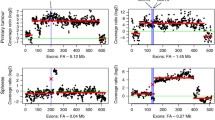Summary
Inactivation of tumour suppressor genes or anti-oncogenes as well as activation of dominant acting oncogenes seem to be important mechanisms in the pathogenesis of gliomas. We compared constitutional and tumoural genotypes at different restriction fragment length polymorphism loci (RFLP) on chromosomes 10 and 17 in 15 unrelated individuals
Loss of heterozygosity (LOH) pointing to chromosomal loss or deletions was detected for at least one chromosme 17 marker in 11 gliomas (astrocytomas grades I–III and glioblastoma multiforme), whereas LOH for chromosome 10 loci was only detected in 3 out of 9 cases of glioblastoma multiforme and was not detected in low grade gliomas. Since LOH for chromosome 10 loci seems to be restricted only to glioblastoma multiforme, it is possible that recessive mutations on chromosome 10 are engaged in tumour progression from astrocytomas to glioblastoma multiforme. As LOH of chromosome 17 markers occurs in astrocytomas as in glioblastoma multiforme, chromosome 17 loci probably are involved in early tumour development.
Similar content being viewed by others
References
Ahuja H, Bar-Eli M, Arlin Z, Advani S, Allen SL, Goldman J, Snyder D, Foti A, Cline M (1991) The spectrum of molecular alterations in the evolution of chronic myelocytic leukemia. J Invest 87: 2042–2047
Baker SJ, Fearon ER, Nigro JM, Hamilton SR, Preisinger AC, Jessup JM, van Tuinen P, Ledbetter DH, Barker DF, Nakamura Y, White R, Vogelstein B (1989) Chromosome 17 deletions andp53 gene mutations in colorectal carcinomas. Science 244: 217–221
Bigner SH, Mark J, Bullard DE, Mahaley MSM, Bigner DD (1986) Chromosomal evolution in malignant human gliomas starts with specific and usually numerical deviations. Cancer Genet Cytogenet 22: 121–135
Bigner SH, Mark J, Mahaley MS, Bigner DD (1984) Patterns of the early, gross chromosomal changes in malignant human gliomas. Hereditas 101: 103–113
Botstein D, White RL, Scolnick M, Davis RW (1980) Construction of a linkage map in man using restriction fragment length polymorphism. Am J Hum Genet 32: 314–331
Burger PC, Vogel FS, Green SB, Strike TA (1985) Glioblastoma multiforme and anaplastic astrocytoma. Pathologic criteria and prognostic implications. Cancer 56: 1106–1114
Church GM, Gilbert W (1984) Genomic sequencing. Proc Natl Acad Sci USA 81: 1991–1995
Cogen PH, Daneshvar L, Metzger AK, Edwards MSB (1990) Deletion mapping of the medulloblastoma locus on chromosome 17 p. Genomics 8: 279–285
El-Azouzi M, Chung RY, Farmer GE, Martuza RL, Black PM, Rouleau GA, Hettlich C, Hedley-White ET, Zervas NT, Panagopoulos K, Nakamura Y, Gusella JF, Seizinger BR (1989) Loss of distinct regions on the short arm of chromosome 17 associated with tumourigenesis of human astrocytomas. Proc Natl Acad Sci USA 86: 7186–7190
Friend SH, Bernards R, Rogley S, Weinberg RA, Rapaport JM, Albert DM, Dryja TP (1986) A human DNA segment with properties of the gene that predisposes to retinoblastoma and oesteosarcoma. Nature 323: 643–646
Fujimoto M, Fults DW, Thomas GA (1989) Loss heterozygosity on chromosome 10 in human glioblastoma multiforme. Genomics 4: 210–214
Human gene mapping. Tenth International workshop on human gene mapping (1989) Cytogenet Cell Genet 51: 650–854
James CD, Carlbom E, Dumanski JP, Hansen M, Nordenskjold M, Collins VP, Cavenee WK (1988) Clonal genomic alterations in glioma malignancy stages. Cancer Res 48: 5546–5551
Knudson AG (1985) Hereditary cancer, oncogenes and antioncogenes. Cancer Res 45: 1437–1443
Knudson AG (1971) Mutation and cancer: statistical study of retinoblastoma. Proc Natl Acad Sci USA 68: 820–823
Larrson C, Skogseid B, Oberg K, Nakamura Y, Nordenskjöld M (1988) Multiple endocrine neoplasia type I maps to chromosome 11 and is lost in insulinoma. Nature 332: 85–87
Levine AJ, Momand J, Finaly CA (1991) Thep53 tumour suppressor gene. Nature 351: 453–456
McBride OW, Merry D, Givol D (1986) The gene for humanp53 cellular tumour antigen is located on chromosome 17 short arm (17 p 13). Proc Natl Acad Sci USA 83: 130–134
Meera Khan P, Tops CMJ, van den Broek M, Breukel C, Wijnen JT, Oldenburg M, van den Bos J, van Leeuwen-Cornelisse ISJ, Vasen HFA, Verspaget HM, den Hartog Jager FCA, Lamers CBHW (1988) Close linkage of a highly polymorphic marker (D 5 S 37) to familial adenomatous polyposis (FAP) and confirmation of FAP localization on chromosme 5q21–q22. Hum Genet 79: 183–185
Miller SA, Dykes DD, Polesky F (1988) A simple salting out procedure for extracting DNA from human nucleated cells. Nucleic Acids Res 16: 1215
Nigro JM, Barker SJ, Preisinger AC, Jessup JM, Hostetter R, Clearly K, Bigner SH, Davidson N, Baylin S, Devilee P, Glover T, Collins FS, Weston A, Modali R, Harris CC, Vogelstein B (1989) Mutations in thep53 gene occur in diverse human tumour types. Nature 342: 705–708
Rey JA, Bello MJ, de Campos JM, Ramos MC, Benitez J (1984) Chromosomal abnormalities in human brain tumours: an analysis of 52 cases. Proc. XVII Annual Meeting of the European Society of Human Genetics Symposium: Cancer and Genetics in 1984. Clin Genet 27: 330–331
Saiki RK, Gelfand DH, Stoffel S, Scharf SJ, Higuch R, Horn G, Mullis KB, Erlich HA (1988) Primer-directed amplification of DNA with a thermostable DNA polymerase. Science 239: 487–491
Thomas GA, Raffel C (1991) Loss of heterozygosity on 6 q, 16q and 17 p in human central system primitive neuroectodermal tumours. Cancer Res 51: 639–643
Venter DJ, Thomas DGT (1991) Multiple sequential molecular abnormalities in the evolution of human gliomas. Br J Cancer 63: 753–757
Vogelstein B, Fearon ER, Hamilton SR (1988) Genetic alterations during colorectal tumour development. N Engl J Med 319: 525–532
Weinberg RA (1989) Oncogenes, anti-oncogenes and the molecular basis of multistep carcinogenesis. Cancer Res 49: 3713–3715
Yamada K, Kondo T, Yoshioka M, Oami H (1980) Cytogenetic studies on twenty human brain tumours: association of 22 chromosome abnormalities with tumours of the brain. Cancer Genet Cytogenet 2: 293–307
Zülch KJ (1979) Histological typing of tumours of the central nervous system. Geneva World Health Organization 1979
Author information
Authors and Affiliations
Rights and permissions
About this article
Cite this article
Van de Keift, E., De Boulle, K., Willems, P. et al. Loss of constitutional heterozygosity in human astrocytomas. Acta neurochir 117, 172–177 (1992). https://doi.org/10.1007/BF01400616
Issue Date:
DOI: https://doi.org/10.1007/BF01400616




